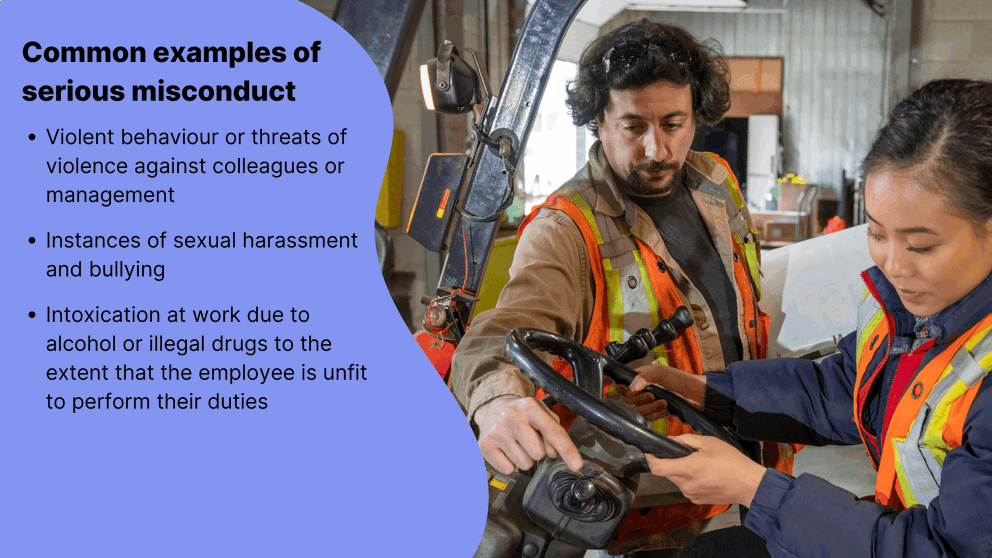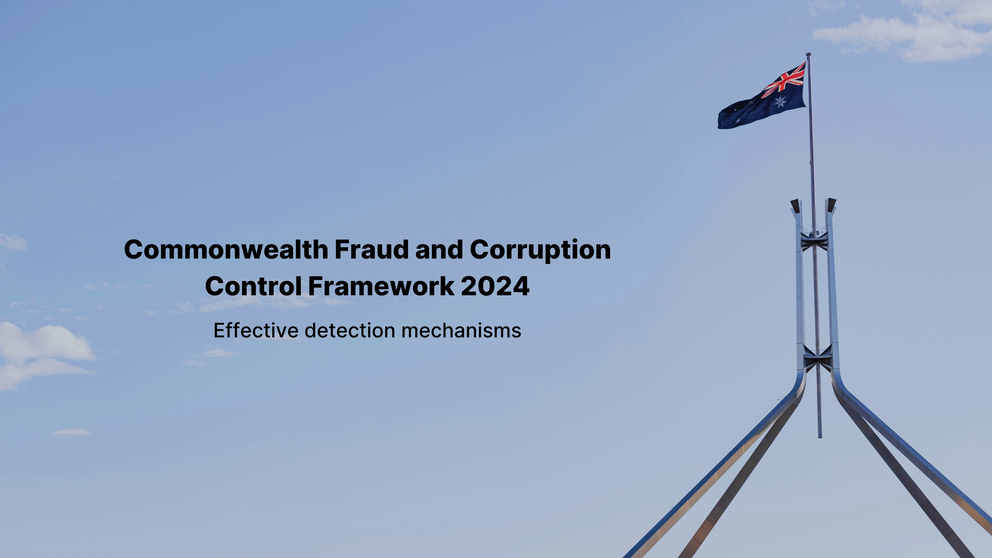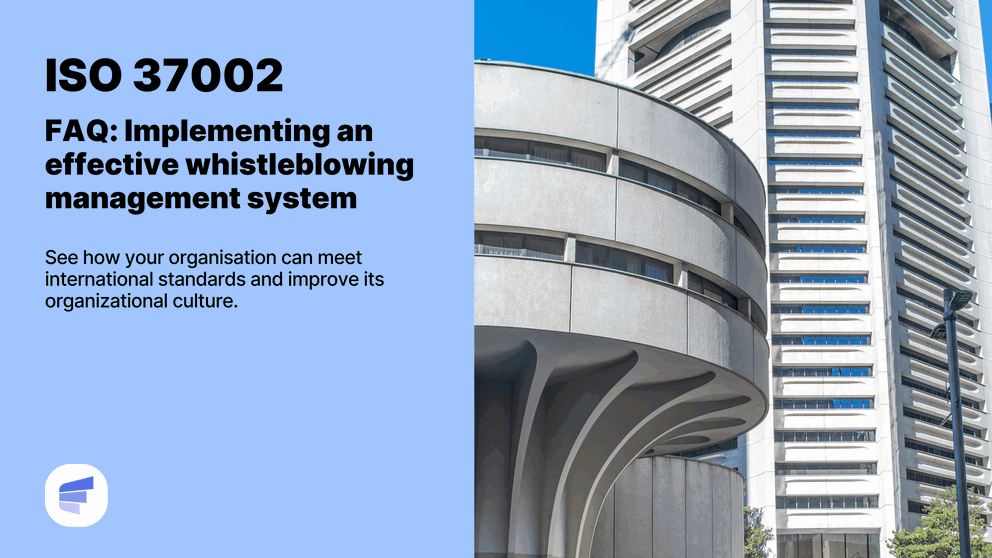Dealing With Serious Misconduct In the Workplace

Key takeaways
- Serious misconduct includes illegal actions or those posing a significant risk to health, safety, or business reputation, leading to immediate termination and potential impact on future employment.
- Employers must thoroughly investigate allegations of serious misconduct following a structured process, maintaining procedural fairness to avoid unfair dismissal claims.
- Maintaining a safe and compliant workplace involves preventing serious misconduct, effective post-investigation support, and adherence to health and safety regulations.
Understanding serious misconduct: definition and implications
Serious misconduct embodies illegal actions that pose a significant risk to the health and safety of employees or the reputation, viability, or profitability of an employer's business. This includes acts such as theft, fraud, assault, or being intoxicated at work. Additionally, wilful or deliberate behaviour, such as willful disobedience, gross negligence, or significant breaches of workplace policies, also qualifies as serious employee misconduct.
The consequences of engaging in serious misconduct are severe. It can lead to:
- Immediate termination of employment without notice or payment in lieu of notice
- Ineligibility for certain entitlements, such as leave payouts and severance pay
- Potential impact on future employment opportunities and professional reputation.
Contrarily, ordinary misconduct, being less severe, often leads to warnings or disciplinary action rather than immediate dismissal. Understanding the difference between serious and ordinary misconduct is vital for employees and employers due to the significant variation in potential consequences.
Fair Work Act 2009 and employment contracts
The Fair Work Act 2009 provides a legal framework for defining serious misconduct, which is deliberate behaviour by an employee that is inconsistent with the continuation of their employment. The definition of serious misconduct under the Act includes specific examples, such as:
- Theft
- Fraud
- Assault
- Intoxication at work
- Willful or deliberate damage to company property
- Breach of company policies or codes of conduct
This term carries substantial weight in the employment relationship and should not be dismissed lightly.
Employment contracts often define serious misconduct and may provide specific examples relevant to the nature of the business or industry. As a result, employees must understand their employment contract and the Fair Work Act to ensure they are aware of the acceptable standards of conduct in the workplace.
Employers are advised to include policies on standards of behaviour, misconduct, and disciplinary action in their employee handbooks and employment agreements, outlining the employee's duties. This way, employees are aware of the expectations and the potential ramifications of any serious misconduct, thus promoting a conducive and compliant workplace during an employee's employment.
Recognising and addressing imminent risks
Serious misconduct is more than just a breach of trust or an act of defiance. It encompasses behaviour that poses a serious and imminent risk to various aspects of the employer's business or individuals' safety. These imminent risks include threats to individuals' health and safety or the reputation, viability, or profitability of the employer's business.
Employers are required to manage these risks appropriately. Failing to do so can result in legal consequences, such as monetary penalties for non-compliance with health and safety regulations. Therefore, identifying and mitigating imminent risks linked to serious misconduct is a key component in maintaining a safe and compliant workplace.

Common examples of serious misconduct
To clarify the concept of serious misconduct, we will examine some typical examples. These include theft from an employer or other employees and fraudulent actions such as falsifying timesheets or expense reports. Such acts are a breach of trust and potentially criminal offences.
Serious misconduct includes:
- Violent behaviour or threats of violence against colleagues or management
- Instances of sexual harassment and bullying
- Intoxication at work due to alcohol or illegal drugs to the extent that the employee is unfit to perform their duties
Additionally, serious breaches of health and safety procedures that endanger others are also deemed as serious misconduct and can warrant termination. Furthermore, engaging in conduct outside of work, such as indecent or unlawful behaviour that damages the relationship with the employer or reflects poorly on the employer's reputation, can be considered serious misconduct.
Lawful and reasonable instructions: A key factor in misconduct cases
The concept of lawful and reasonable instructions is crucial in determining misconduct cases. A direction is considered lawful and reasonable if it is within the scope of the employee's role, involves no illegality, and is appropriate regarding the circumstances. This principle applies to both private and public sectors. The Australian Public Service Commission requires that directions to public servants promote integrity and public confidence in the service.
Refusal to execute a lawful and reasonable instruction pertaining to one's job duties can be indicative of serious misconduct. Intentional non-compliance with instructions from superiors that are lawful and reasonable is viewed as serious misconduct. It is an implied condition in Commonwealth employment contracts in Australia that employees adhere to lawful and reasonable instructions from their employers. Therefore, comprehension and adherence to lawful and reasonable instructions are vital to preventing serious misconduct.
Investigating allegations of serious misconduct
When allegations of serious misconduct arise, they must be investigated thoroughly and objectively. A workplace investigation is an independent process designed to ascertain facts regarding allegations of serious misconduct, eliminating perceived bias. This process involves the complainant and respondent, witnesses, a support person, and the investigator, contributing to a structured six-step process for thorough fact-finding. The six steps of a workplace investigation are:
- Planning and preparation
- Gathering evidence
- Conducting interviews
- Analysing the evidence
- Making findings and conclusions
- Preparing the investigation report
- Employers can ensure a fair and comprehensive investigation process by following these steps.
The standard of proof in workplace investigations is the balance of probabilities, where various types of evidence are collected. Therefore, employers should systematically document all aspects of the investigation, including:
- Interviews
- Meetings
- Warnings
- Decisions
This will help maintain records substantiating the investigation's findings and procedural fairness.
However, the investigation process must also follow fair procedures. Any rushed decisions or lack of a proper response can lead to accusations of unfair dismissal. Thus, conducting a well-executed workplace investigation supports the employer's decisions and can reduce the risk of legal challenges from unfair dismissal claims.
Avoiding unfair dismissal claims
Employers must also tread carefully when dealing with serious misconduct to avoid unfair dismissal claims. A dismissal can be deemed harsh, unjust, or unreasonable if the termination process lacks procedural fairness, even if the employee violated lawful and reasonable instructions. Therefore, employers should provide a clear warning about the consequences of misconduct, unless it’s a case of summary dismissal for gross misconduct, to maintain procedural fairness.
To avoid unfair dismissal allegations, it is vital to:
- Avoid hasty decisions
- Ensure ample time for a thorough investigation and response
- Allow employees to have a support person of their choice during the disciplinary process
Denying an employee's choice of a support person during the disciplinary process can lead to procedural unfairness, potentially affecting the outcome of unfair dismissal claims, especially in cases of an employee refusing to cooperate without their chosen support person.
To further reduce the risk of unfair dismissal claims, the reason for dismissal must be substantiated, defensible, and genuinely related to the employee’s capacity or conduct. Legal advice prior to terminating an employee for serious misconduct can help ensure that the employer complies with employment laws and minimises the risk of an unfair dismissal claim.
Disciplinary actions and termination procedures
Once serious misconduct has been established, it must be addressed firmly. Under the Fair Work Act, serious misconduct may warrant immediate termination without notice or payment in lieu of notice, emphasising the gravity of such violations. However, this is not the only course of action. An employee may be suspended with full pay during the disciplinary process if they pose a risk of harm to people or the business.
Typical initial disciplinary actions for misconduct can range from a verbal or written warning to letters of concern or final written warnings. Disciplinary meetings allow the accused employee to prepare and present extenuating circumstances with at least 24-48 hours' notice and the right to bring a support person.
Employers must follow their internal disciplinary procedures and pertinent industry standards when handling serious misconduct cases. This not only ensures fair treatment of the employee but also protects the employer from potential legal repercussions and safeguards the employer's business.
Employee support and representation
Employees have the right to bring a support person to assist them during the disciplinary process. This can be:
- a colleague
- a friend
- a family member
- a union representative
- a lawyer
- any other person the employee trusts
Employers must inform employees of this right during discussions about dismissal, ensuring procedural fairness.
A support person's primary responsibility is to provide emotional support and assist the employee by clarifying questions or taking notes. They should not advocate or speak for the employee but may provide clarification and request brief breaks if necessary. However, the employer can reasonably refuse a proposed support person if they are involved in the issues addressed or part of the decision-making process or cannot attend within a reasonable timeframe.
If a support person disrupts the meeting, the employer can pause to remind them of their role or reschedule the meeting with a different support person if necessary. Thus, the presence and role of a support person play a significant part in the disciplinary process, as they contribute to procedural fairness and provide necessary assistance to the employee.

Maintaining a Safe and Compliant Workplace
Maintaining a safe and compliant workplace is a collective responsibility. Leadership is pivotal in fostering a workplace culture that upholds ethical behaviour and discourages misconduct, with leaders accountable for setting and demonstrating ethical standards and behaviours. Establishing zero-tolerance policies for misconduct and having transparent reporting processes encourages a culture of compliance and ensures that incidents are dealt with promptly and fairly.
Compliance with health and safety regulations is vital in preventing serious workplace misconduct and minimising the possibility of accidents. This necessitates proper training, access to safe equipment, and safe work environments. Health and Safety Representatives have a pivotal role in monitoring and enforcing safety regulations, with specific training and the authority to halt work over serious immediate safety concerns.
Post-investigation, organisations must support employees and ensure safety and wellbeing while managing any long-term changes or victimisation from the investigation. Thus, maintaining a safe and compliant workplace is not just about preventing serious misconduct but also about handling it appropriately when it does occur.
How anonymous reporting tools can help your organisation
Maintaining a safe and compliant workplace requires a collective effort from all stakeholders – from leadership setting the tone of ethical behaviour, employees abiding by the rules and regulations, and the right systems and processes to address misconduct when it arises. By doing so, we create not just a workplace that is safe and compliant but one that promotes integrity, fairness, and respect.
Integrating anonymous reporting tools into the workplace serves as a proactive measure for the early detection of workplace issues. These tools empower employees to report concerns without fear of retaliation, ensuring that potential problems can be addressed before they escalate into serious misconduct. By providing a secure channel for communication, anonymous reporting tools help in maintaining a safe environment for all employees and safeguarding the reputation and integrity of an organisation.
Elker, an innovative anonymous reporting platform, is designed to facilitate employees in speaking up about workplace issues. With its end-to-end encrypted whistleblowing tools, real-time analytics, and pulse surveys, Elker offers a comprehensive solution for the detection and management of workplace concerns. These features not only encourage a culture of openness and transparency but also help in identifying patterns that could indicate deeper systemic problems.
If you would like to know more about how Elker can transform your approach to workplace safety and compliance, book a demonstration of the platform today.


